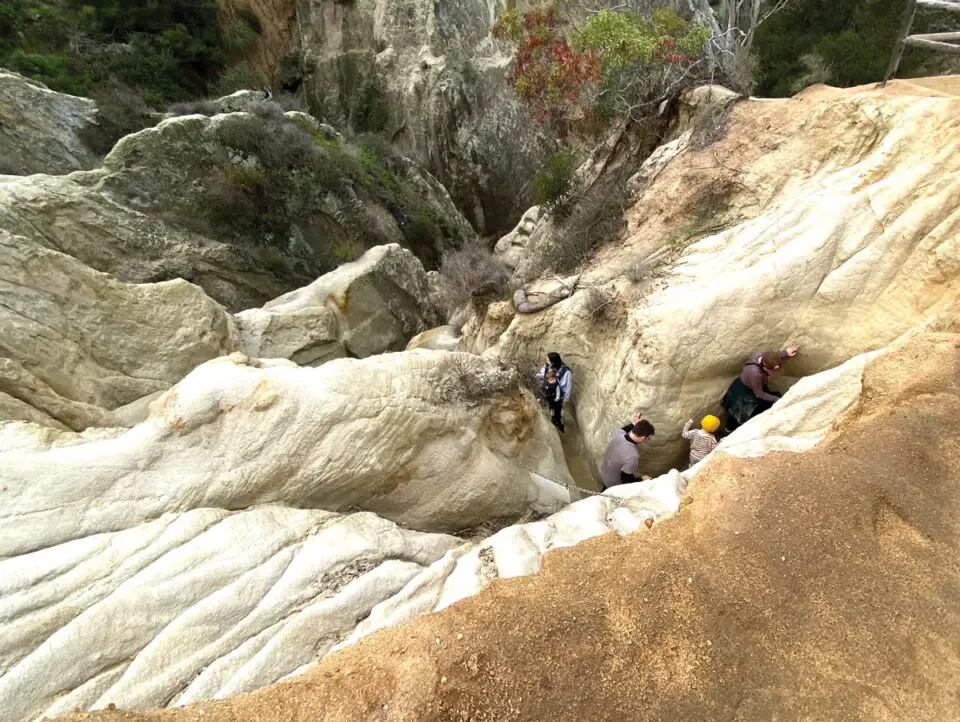Our quest for a bit of local adventure during the holidays took us to Annie’s Canyon Trail.
When I first learned about this amazing little piece of Solana Beach real estate, I thought I’d discovered a best-kept secret. When we arrived at about 10 a.m. on a Thursday, however, the word clearly had gotten out.
The side streets were lined with cars, clumps of people were walking into and out of the canyon, and more than one foreign language could be heard. I postulated that these were spoken mostly by people who got stuck in San Diego because of Southwest Airlines’ holiday meltdown. To that I say: You could’ve done a whole lot worse.

Heading in, our clump included my husband; brother-in-law, Ross; 7-year-old Landon; and 10-year-old Dakota, all eager to see this wonder of Mother Nature and have some fun too.
For the uninitiated, Annie’s Canyon is an almost-magical, sandstone slot canyon located where you’d never expect to find one: not far from Interstate 5 and adjacent to a residential area.
Also, important to know is that there are two entrances to the trails that lead to the canyon. One, the North Rios Trail is nearly flat. The other, the Solana Hills Trail, which we chose (despite my husband’s warning), is quite steep. The uphill portion is on the return, so be prepared.
After a 0.7-mile walk, we turned left into the beginning of the canyon, and that’s where the fun began. Suddenly, most of the freeway noise melted away and the steep sandstone walls appear. At this point, the walls are still wide apart and the configuration reminded me of a river delta.
Our kid-hikers were suddenly captured by what they saw: thousands of carvings into the sandstone walls. Initials surrounded by hearts and contemporary slogans are hardly ancient art, and it is sad that these walls have been defaced, but these amazing land forms used to look a lot worse.
At one time, they were covered in various shades of glossy paint and the slot canyon floor, cubbyholes and caves littered with trash. Then a lovely lady named Annie stepped in and either raised and/or donated money for the purchase and care of the canyon, which was named after her. (Despite a search, this is all I have learned about Annie.)

As we headed “upstream,” the trail rises and the distance between the walls grows narrower, until some people must navigate the passage sideways. On either side of the canyon trail, there are prime examples of the wondrous actions of wind and water erosion, which have created some unearthly-like formations, hollows and patterns.
We eventually arrived at the ladder — two sets of heavy, stainless-steel rungs bolted into the canyon sides that take hikers to the top of the canyon and a panoramic view of San Elijo Lagoon Ecological Reserve. From this perch, you also can peer down into the canyon and watch other hikers meet the ladder challenge.
Important notes at this point:
• If you are vertically challenged, you’ll need a boost from behind to reach the bottom rung of this ladder.
• Dogs on leashes are permitted, but be prepared to carry Fido up the ladder.
• The trail through the canyon is one way because eventually the canyon is so narrow you can’t turn around.

Once at the top, Dakota begged and begged to navigate the canyon again, but we had to promise to return on another day. We continued, instead, on the Lagoon Loop, which took us close to the shallow-water estuary where migrating waterfowl can be seen.
There also were plenty of ducks enjoying the lagoon, and Dakota and Landon debated for 20 minutes whether the object floating in the water was a stick or a baby alligator.
For more photos, visit www.facebook.com/elouise.ondash.



